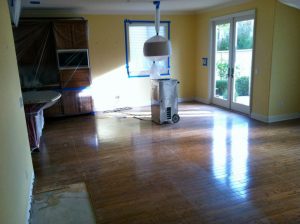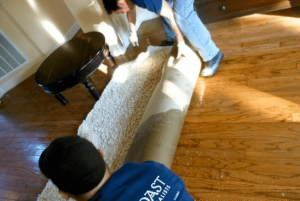Flooded Home Hacks

When water unexpectedly enters your home, it can wreak havoc, causing damage to furniture, walls, floors, and even the structure of the house itself. Immediate action is essential to mitigate the damage and restore your living space to its pre-flood condition. While the aftermath can be overwhelming, there are a few surprising fixes that can help you tackle the devastation. Here are ten of them:
10 Surprising Hacks for a Flooded Home
- Rice Isn’t Just for Phones: You’ve probably heard about the trick of putting a waterlogged phone in a bowl of rice to absorb moisture. On a larger scale, using desiccants like silica gel packets can help absorb moisture in smaller confined areas of the home, like cabinets and closets. While they can’t dry out entire rooms, they’re useful for protecting documents, photos, and electronics from lingering moisture after a flood.
- Aluminum Foil Can Be Your Flooring’s Best Friend: Once you’ve cleared out standing water, you might notice that your wet furniture can stain carpets or wooden floors. A quick and surprising fix? Put aluminum foil or plastic wrap under the furniture legs. This will prevent any dyes or stains from the wet furniture from transferring onto your flooring, giving you one less thing to worry about during the recovery process.
- Chalk for Moisture Absorption: Common chalk, like the kind used for blackboards, can absorb moisture surprisingly well. This is particularly useful for small, damp areas like drawers or shelves. Just place several sticks of chalk in the affected areas, and let them do their work. Over a day or two, they can help to draw out and absorb some of the unwanted moisture.
- Frozen Toys and Books: Did your child’s favorite book or toy get soaked in the flood? Do not throw them out yet! For items like books, you can place them in a plastic bag and freeze them. This stops mold growth and the spread of damage. Later on, you can slowly thaw and air them out, potentially saving a beloved item.
- Vacuum Sealing Your Documents: Important documents can suffer greatly during floods. If you can’t immediately dry them out, consider vacuum sealing them. This prevents further damage from contact with air and moisture. Once sealed, you can deal with them systematically, perhaps using desiccants or professional services to dry and restore them.
- Using Hair Dryers and Fans Simultaneously: After water damage, it’s common to use fans to help dry out rooms, but the power of combining them with a hairdryer can be surprising. While the fan circulates air, use the hair dryer to target specific wet spots, especially in hard-to-reach areas like corners or inside cabinets. Together, they can speed up the drying process considerably
- DIY Water Barrier with Sandbags and Plastic Sheeting: If you’re anticipating a flood or find yourself in the midst of one, you can create a makeshift barrier to prevent more water from entering. Stack sandbags outside entrances, windows, or any vulnerable points. On the inside, lay down heavy-duty plastic sheeting or tarpaulin, taping it securely to the walls. This won’t make your home waterproof, but it can certainly reduce the amount of water that seeps in.
- White Vinegar for Mold Prevention: If you’re concerned about mold but can’t access commercial mold treatments immediately, white vinegar can be a helpful solution. Vinegar’s acidic nature helps prevent mold growth on surfaces. Simply fill a spray bottle with white vinegar and spray it onto the affected areas, letting it dry. Remember, while this is a temporary solution, it’s no substitute for professional mold remediation if the problem persists.
- Hydrogen Peroxide for Sanitizing: Flood waters, especially if they come from outside or sewer backups, can be laden with contaminants. Hydrogen peroxide (3% solution) is a safe and effective disinfectant for many surfaces in your home. Apply it directly to areas that have come into contact with floodwaters, let it sit for a few minutes, then wipe away. This can help reduce the risk of bacterial and viral infections.
- Baking Soda for Odor Removal: Even after the water has been removed, the musty smell of a flood can linger. Baking soda is a natural deodorizer. Sprinkle it generously on carpets, rugs, and other soft surfaces. Let it sit for a few hours or overnight, then vacuum it up. This can help absorb and neutralize some of the unpleasant odors left behind by floodwaters.

Protect Your Home from a Water Heater Flood
While these hacks can be useful in the aftermath of a flood, they are supplementary solutions. A comprehensive approach involving professional assistance is crucial to ensure your home is safe, clean and restored to its former state.

5 Common Questions (and Answers) About Homes That Have Experienced Flooding
Question: How quickly should I address the flood damage?
Answer: Immediate action is critical. Within the first 24-48 hours, mold can begin to grow, and structural damage can worsen. It’s essential to start the process of removing standing water, drying out the space, and assessing the damage as soon as possible to prevent further complications.
Question: Can I stay in my home after it has flooded?
Answer: It depends on the severity of the flood and the affected areas. If there’s significant water damage, especially in essential living areas or to your home’s electrical system, it may be unsafe to remain in the house. Additionally, if there’s a risk of mold growth or if the water is contaminated (e.g., sewage backup), it’s recommended to find an alternative place to stay until the home is restored and sanitized.
When it’s time to reenter your flooded home, safety should be your top priority. Before stepping inside, ensure the main power supply is turned off to avoid electrocution hazards. Always wear protective clothing, including rubber boots and gloves, to safeguard against potential contaminants in the water. Inspect the home’s structural integrity from the outside first — look for visible damages like cracks or sagging, as these might indicate an unsafe environment.
Question: Will my homeowner’s insurance cover the flood damage?
Answer: This varies based on your insurance policy. Standard homeowner’s insurance doesn’t typically cover flooding caused by external factors, like heavy rain or rising rivers. However, if the flooding resulted from a burst pipe or other covered peril, your insurance might pay for repairs. Many homeowners in flood-prone areas purchase additional flood insurance to cover potential damages. Always consult with your insurance agent to determine the specifics of your coverage.
Question: How can I prevent mold growth after a flood?
Answer: Mold thrives in moist environments, so rapid drying is essential. Remove standing water immediately, use fans and dehumidifiers to dry out the area, and open windows if the weather permits. Discard porous items (like carpets, upholstered furniture, or damaged drywall) that can’t be thoroughly dried or cleaned. It’s also beneficial to clean all affected areas with a mold-preventative cleaner. If you suspect mold growth, consider consulting with a mold remediation specialist.
Question: What items can be saved, and what should be discarded after a flood?
Answer: Non-porous items, such as metal, glass, or hard plastic, can often be cleaned and disinfected. However, porous materials like carpets, upholstery, mattresses, and particleboard may need to be discarded if they can’t be fully dried or cleaned, especially if the floodwater is contaminated. Documents, photographs, and some electronics can potentially be restored with specialized services, but it’s case-dependent. When in doubt, consult with water damage restoration professionals to assess what can be saved.
When dealing with a flooded home, it’s essential to prioritize safety, act quickly, and consult with professionals when necessary to ensure the best recovery outcome.
Call Gold Coast Flood Restorations if You Have a Flooded Home (619) 449-9611
In conclusion, while floods can be devastating, the restoration process might have a few unexpected helpers. These surprising fixes can play an important role in your recovery efforts. However, always remember that while these DIY fixes can help in the short term, consulting a professional water damage restoration company is essential for assessing and addressing all the damage caused by a flood. They have the expertise and equipment to ensure that your home is not only dry but also safe from potential mold growth and structural damage.










Also find us on…